|
|
|
Sort Order |
|
|
|
Items / Page
|
|
|
|
|
|
|
| Srl | Item |
| 1 |
ID:
101038
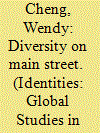

|
|
|
|
|
| Publication |
2010.
|
| Summary/Abstract |
The emergence in the United States of an increasing number of spaces across the socioeconomic spectrum with majority nonwhite populations merits close attention because of these spaces' potential in reconfiguring historical and contemporary claims to place. In an era in which the neoliberalization of urban development has spurred local governments toward more active involvement in defining relationships between race, ethnicity, consumption, and space, "majority-minority" suburbs are particularly important sites of study. In the late 2000s, two branding campaigns in majority-Asian American and Latina/o municipalities in Los Angeles's San Gabriel Valley-a densely populated region popularly known as a "suburban Chinatown"-put forth specific discourses of race, ethnicity, and culture in attempts to actualize specific visions and claims to place, identity, and history. In doing so, these campaigns illuminated and reinforced larger racial, geographic, and ideological divides. "Diversity" on Main Street embraced pluralist multicultural discourses of the nation, while the "Golden Mile" proposal sought to showcase the transformation of a central thoroughfare by ethnic Chinese capital and immigration. A close examination and comparison of these two campaigns shows how struggles over race, geography, and history are intertwined in the contemporary identities of places and integral to the shaping of civic landscapes.
|
|
|
|
|
|
|
|
|
|
|
|
|
|
|
|
| 2 |
ID:
137713


|
|
|
|
|
| Summary/Abstract |
Drawing on recent research in urban policy studies and social studies of technology, this paper examines the capability of urban energy regimes in adapting to environmental policy pressures. Focusing on the case of the City of Los Angeles, we critically analyze the transformative capacity of the city׳s recent energy and climate policies and the innovation patterns of its urban infrastructure regime. This case study suggests that despite considerable success in switching from coal to renewable energies, the patterns of sociotechnical change in Los Angeles still tend to supplement and sustain the existing regime. Sociotechnical change in Los Angeles tends to unfold incrementally through adjustments within the established patterns of the existing regime.
|
|
|
|
|
|
|
|
|
|
|
|
|
|
|
|
| 3 |
ID:
110553
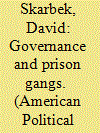

|
|
|
|
|
| Publication |
2011.
|
| Summary/Abstract |
How can people who lack access to effective government institutions establish property rights and facilitate exchange? The illegal narcotics trade in Los Angeles has flourished despite its inability to rely on state-based formal institutions of governance. An alternative system of governance has emerged from an unexpected source-behind bars. The Mexican Mafia prison gang can extort drug dealers on the street because they wield substantial control over inmates in the county jail system and because drug dealers anticipate future incarceration. The gang's ability to extract resources creates incentives for them to provide governance institutions that mitigate market failures among Hispanic drug-dealing street gangs, including enforcing deals, protecting property rights, and adjudicating disputes. Evidence collected from federal indictments and other legal documents related to the Mexican Mafia prison gang and numerous street gangs supports this claim.
|
|
|
|
|
|
|
|
|
|
|
|
|
|
|
|
| 4 |
ID:
100526
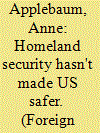

|
|
|
| 5 |
ID:
086883
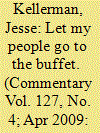

|
|
|
|
|
| Publication |
2009.
|
| Summary/Abstract |
When I was four, we went to Oahu. It was the first time we celebrated Passover away from home. My only memory of the trip is of the ride to the Los Angeles airport. Our neighbor, Mr. Janis, drove a taxi. He loaded up our luggage and we all crammed in: my father up front and my mother in back with my sister Rachel and me. Rachel was then just shy of a year old, as yet incapable of communicating distress in any manner other than a wail. She was wailing as Mr. Janis started the car. We had not yet pulled away from the curb when she vomited explosively across the faux leather seats. My father apologized. My mother ran back into the house for sponges and Lysol. Somehow we made our flight. I assume we had a good time, because we went back again the next year. What is clear in hindsight is that Rachel was trying to warn us.
|
|
|
|
|
|
|
|
|
|
|
|
|
|
|
|
| 6 |
ID:
118793
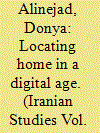

|
|
|
|
|
| Publication |
2013.
|
| Summary/Abstract |
This paper explores how children of Iranian immigrants engage with internet media in processes of identity formation. It conceptually centralizes places of home in order to bring together literatures on diaspora and digital media in order to understand the case of the second-generation immigrant home. It argues that this partially mediated home is both connected/mobile and emplaced/embodied. It is in this sense that the article discusses processes of locating home, in the sense of both a narrated discovery and a materially situated formation. The findings are generated from ethnographic fieldwork among second-generation Iranian Americans in Los Angeles carried out over a period of twelve months as part of an ongoing doctoral project with a focus on respondents' everyday practices of internet usage.
|
|
|
|
|
|
|
|
|
|
|
|
|
|
|
|
| 7 |
ID:
092060
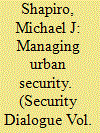

|
|
|
|
|
| Publication |
2009.
|
| Summary/Abstract |
This article locates the contemporary security climate of the city of Los Angeles within a historical trajectory of modes of securitization. While some of the analysis treats the material and technological aspects of cities in general, and Los Angeles in particular, much of my emphasis, articulated in readings of both literary and film versions of police procedurals, is on discursive barriers. Ultimately, I suggest that, materially and discursively, urban America features class and ethnic fault lines that serve as the primary bases of security management.
|
|
|
|
|
|
|
|
|
|
|
|
|
|
|
|
| 8 |
ID:
176800
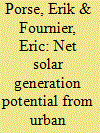

|
|
|
|
|
| Summary/Abstract |
Rooftops provide accessible locations for solar energy installations. While rooftop solar arrays can offset in-building electricity needs, they may also stress electric grid operations. Here we present an analysis of net electricity generation potential from distributed rooftop solar in Los Angeles. We integrate spatial and temporal data for property-level electricity demands, rooftop solar generation potential, and grid capacity constraints to estimate the potential for solar to meet on-site demands and supply net exports to the electric grid. In the study area with 1.2 million parcels, rooftop solar could meet 7200 Gigawatt Hours (GWh) of on-site building demands (~29% of demand). Overall potential net generation is negative, meaning buildings use more electricity than they can produce. Yet, cumulative net export potential from solar to grid circuits is 16,400 GWh. Current policies that regulate solar array interconnection to the grid result in unutilized solar power output of 1700 MW. Lower-income and at-risk communities in LA have greater potential for exporting net solar generation to the grid. This potential should be recognized through investments and policy innovations. The method demonstrates the need for considering time-dependent calculations of net solar potential and offers a template for distributed renewable energy planning in cities.
|
|
|
|
|
|
|
|
|
|
|
|
|
|
|
|
| 9 |
ID:
171066
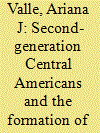

|
|
|
|
|
| Summary/Abstract |
Whether Latinos in the United States are an ethnic or racial group is extensively debated. Some propose Latinos are an ethnic group on their way to becoming white, others contend Latinos are a racialised group, and an alternate perspective posits Latinos are an ethnoracial group. This study intervenes in this debate by examining the identities of second- and 1.5-generation Central Americans in Los Angeles, California. Drawing on 27 in-depth interviews, I show Central Americans have an identity repertoire, which includes national origin, panethnic, racial, and minority identities. I also capture the situations and reference groups that influence the deployment of ethnic and racial identities. These results suggest Central Americans develop an ethnoracial identity. I argue Central Americans’ ethnoracial identity emerges from agency – subjective understandings of themselves and resisting invisibility in Mexican Los Angeles – and from structure – a racialised society, institutionally-created panethnic categories, and racially-based experiences.
|
|
|
|
|
|
|
|
|
|
|
|
|
|
|
|
| 10 |
ID:
105173
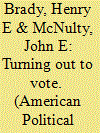

|
|
|
|
|
| Publication |
2011.
|
| Summary/Abstract |
Could changing the locations of polling places affect the outcome of an election by increasing the costs of voting for some and decreasing them for others? The consolidation of voting precincts in Los Angeles County during California's 2003 gubernatorial recall election provides a natural experiment for studying how changing polling places influences voter turnout. Overall turnout decreased by a substantial 1.85 percentage points: A drop in polling place turnout of 3.03 percentage points was partially offset by an increase in absentee voting of 1.18 percentage points. Both transportation and search costs caused these changes. Although there is no evidence that the Los Angeles Registrar of Voters changed more polling locations for those registered with one party than for those registered with another, the changing of polling places still had a small partisan effect because those registered as Democrats were more sensitive to changes in costs than those registered as Republicans. The effects were small enough to allay worries about significant electoral consequences in this instance (e.g., the partisan effect might be decisive in only about one in two hundred contested House elections), but large enough to make it possible for someone to affect outcomes by more extensive manipulation of polling place locations.
|
|
|
|
|
|
|
|
|
|
|
|
|
|
|
|
|
|
|
|
|